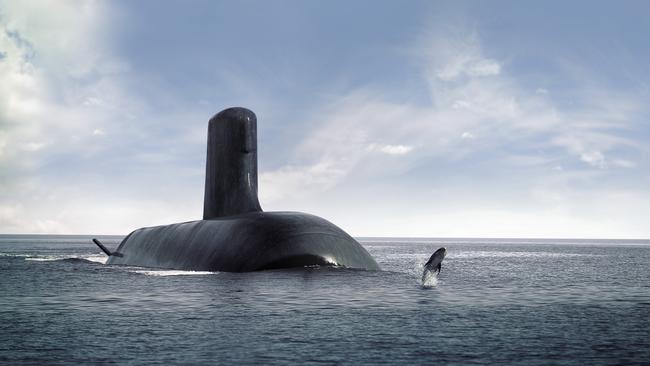Future submarines: Are we getting our scientific boom?
Australia’s ambitious future submarine project has been nothing if not a magnet for lofty claims.

The future submarine project has been nothing if not a magnet for lofty claims: the most expensive Australian defence acquisition ever; second only to building a space shuttle in terms of engineering difficulty.
And according to prime minister Malcolm Turnbull in 2016, when French company DCNS (now renamed Naval Group) was chosen to build the new subs, it was a project that would “secure our successful transition to the economy of the 21st century” with “immense spin-offs into the rest of the economy”.
As this century’s third decade begins and fully four years after the announcement, are we seeing this promised defence-induced, hi-tech economic transformation?
“The short answer is no,” says Marcus Hellyer from the Australian Strategic Policy Institute in Canberra. “And the long answer is we never will, not via the future submarine project and projects like it.”
Certainly sticker shock played its part in raising expectations. To design and build the future submarines will cost $50 billion in today’s dollars, or $80bn inflation adjusted or “turned out”, in Defence parlance.
But it has been a slow start. The strategic partnership agreement was completed in February last year. Now the design phase is under way, but construction in Adelaide is not expected to start until 2022.
“To maximise the economic spin-offs, you need to support particular sectors, and they’re not the large traditional 20th-century-style industrial ones,” Hellyer says.
“It is all about hi-tech industry, where you can play on our domestic strengths in university research, generate intellectual property, and then produce products and services you can sell to the world.”
Amid controversy earlier this year about local industry participation, Naval Group committed to spend 60 per cent of the contract value locally and disclosed 137 current domestic subcontractors.
Alongside various defence equipment suppliers and engineering services firms — some of whom are local subsidiaries of foreign companies — the list also included a French language training provider, accounting firms and recruitment firms.
Naval Group’s Sydney-based Naval Group Pacific, which among other things has a remit for funding research and development. US company Lockheed Martin, which is building the future submarines’ combat system for an estimated 40 per cent of the submarines’ overall price, declined to guarantee a minimum local spend.
But it has awarded $900,000 research and development seeding grants for local academic and industry partners to propose advanced technologies for the future submarine program.
“As far as I can see, the Attack-class program is not being set up to develop hi-tech innovations,” Hellyer says.
“The program will rely on existing technologies. It isn’t pursuing new, indigenously developed technologies. Four of the five major subsystems have been selected and they are Naval Group’s usual European suppliers. The combat system will be the existing one used on the Virginia-class and the Collins. So the program will create work and demand for components, but promoting indigenous technological innovation does not seem to be a high priority.”
–
“There are potentially areas of military technology where investment in local industry would not only have economic benefits but also provide military capability advantages
— Marcus Hellyer, Australian Strategic Policy Institute
–
But even if a proportion of the contract value trickles into local hi-tech firms, many experts are worried about the cost to the taxpayer to get it there.
According to an ASPI report in August last year, the price premium for preferring Australian over foreign construction for the future submarines was estimated by Defence and published by the Australian National Audit Office at 15 per cent.
Analysts have argued that seems low relative to the published premium for future major surface combatants of 15 to 20 per cent, when publicly available evidence suggests that submarines should attract a higher, rather than lower, premium.
“A classic economist would tell you that every dollar spent in premium is a dollar not invested in some other part of the economy where we are more efficient, where do we have competitive advantages, where there are clear economic spin-offs,” Hellyer says.
“There are potentially areas of military technology where investment in local industry would not only have economic benefits but also provide military capability advantages, including unmanned systems, artificial intelligence, advanced sensors (including passive radar), micro and nano satellites.
“In my view there is much greater bang for the buck to be achieved in those areas. There is a much greater likelihood of exports in those areas than submarines.
“There is also much more room for quick technological wins, whereas conventional submarines are in some ways at the end of their design cycle.”
According to Hellyer, the coronavirus pandemic and the resulting budget pressures should not adversely affect the future submarine project; quite the opposite.
“I’d say it’s virtually certain that the government will continue to prioritise the build of ships and submarines as a way of showing it is spending locally,” he says.
“It has already said it will do so. After COVID-19 will it want to create even a hint of doubt about the creation of shipbuilding jobs?
“There will not be any greater scrutiny as both major parties will be trying to outdo each other in the ‘build in Australia’ stakes.”
The sheer size of the fiscal stimulus, in the hundreds of billions, may move the cost and unproven economic claims of the future submarine project out of the crosshairs. In the end, the biggest claim in relation to the program, and arguably the only one that counts, is that the boats will be “regionally superior”.



